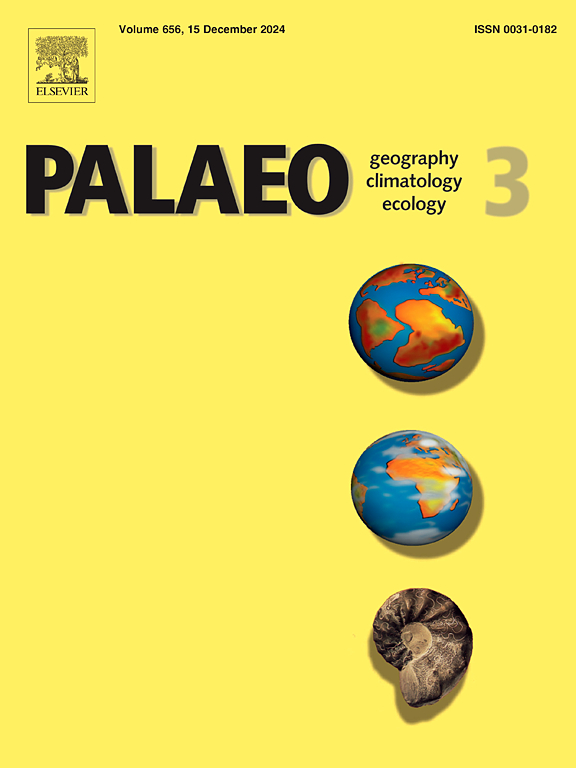Dismembered Guadalupian (Middle Permian) seamounts within the Yarlung-Tsangpo Suture Zone: Implications for the opening time of the Neo-Tethys Ocean
IF 2.7
2区 地球科学
Q2 GEOGRAPHY, PHYSICAL
Palaeogeography, Palaeoclimatology, Palaeoecology
Pub Date : 2025-05-29
DOI:10.1016/j.palaeo.2025.113063
引用次数: 0
Abstract
The opening time of the Neo-Tethys Ocean has been the subject of intense debates. In this paper, we document several exotic limestone blocks within the ophiolite mélange in the southern branch of the Yarlung-Tsangpo Suture Zone (Daba-Xiugugabu ophiolite subzone), which provide insights into the early evolution of the Neo-Tethys Ocean. The limestone blocks contain diverse fusulines such as Neoschwagerina and Kahlerina in the limestones in the Gyanyima area (Burang County) as well as Codonofusiella, Lantschichites, Neoschwagerina, Chusenella, Yangchienia and Kahlerina in the Zhalairi area (Zhongba County). These fusuline assemblages totally suggest a Middle Permian (late Guadalupian) age. The faunal characteristics of the fusulines indicate marine conditions that were warmer than the Gondwanan-type fauna in the Tethys Himalaya Terrane and the Zhongba-Zhada microcontinent, indicating that the limestone blocks were originated from a lower latitude to the north of the Gondwana continent. They further suggest that the limestone blocks are not in situ but derived from the obducted mélange from the ophiolites in the north of the Zhongba-Zhada microcontinent (Dajiweng-Saga ophiolite subzone), further suggesting a homology between the two ophiolite belts on both sides of the Zhongba-Zhada microcontinent. Considering the paleobiogeographic affinities and the data from paleomagnetic and geochemical studies of the associated basalt, it is proposed here that a seamount chain was developed in the Neo-Tethys Ocean during the late Guadalupian time, and that the Neo-Tethys Ocean had opened during the Early Permian (Cisuralian) times.
雅鲁藏布缝合带内瓜达鲁番(中二叠世)海山的肢解:对新特提斯洋开放时间的启示
新特提斯洋的开放时间一直是激烈争论的主题。本文记录了雅鲁藏布江缝合带南支蛇绿岩区(大坝-秀谷加布蛇绿岩亚带)内的几个奇特的石灰岩块体,为新特提斯洋的早期演化提供了新的认识。其中,干阳玛地区(布朗县)的灰岩中含有Neoschwagerina和Kahlerina等多种细粒岩,扎日地区(中巴县)的灰岩中含有Codonofusiella、Lantschichites、Neoschwagerina、Chusenella、Yangchienia和Kahlerina等细粒岩。这些fusuline组合完全表明了中二叠世(瓜达鲁普晚期)的时代。其动物区系特征表明,其海洋环境比特提斯-喜马拉雅地体和中坝-扎达微大陆的冈瓦纳型动物区系温暖,表明其灰岩块体起源于冈瓦纳大陆北部较低的纬度。研究结果进一步表明,这些灰岩块不是原位形成的,而是来自于中坝-扎达微大陆北部蛇绿岩(大基翁山-萨嘎蛇绿岩亚带)的隆起,进一步表明中坝-扎达微大陆两侧的两条蛇绿岩带具有同源性。结合古生物地理亲缘关系和相关玄武岩的古地磁和地球化学研究资料,认为新特提斯洋在瓜达鲁普世晚期发育海山链,新特提斯洋在早二叠世(顺拉纪)开放。
本文章由计算机程序翻译,如有差异,请以英文原文为准。
求助全文
约1分钟内获得全文
求助全文
来源期刊
CiteScore
5.90
自引率
10.00%
发文量
398
审稿时长
3.8 months
期刊介绍:
Palaeogeography, Palaeoclimatology, Palaeoecology is an international medium for the publication of high quality and multidisciplinary, original studies and comprehensive reviews in the field of palaeo-environmental geology. The journal aims at bringing together data with global implications from research in the many different disciplines involved in palaeo-environmental investigations.
By cutting across the boundaries of established sciences, it provides an interdisciplinary forum where issues of general interest can be discussed.

 求助内容:
求助内容: 应助结果提醒方式:
应助结果提醒方式:


